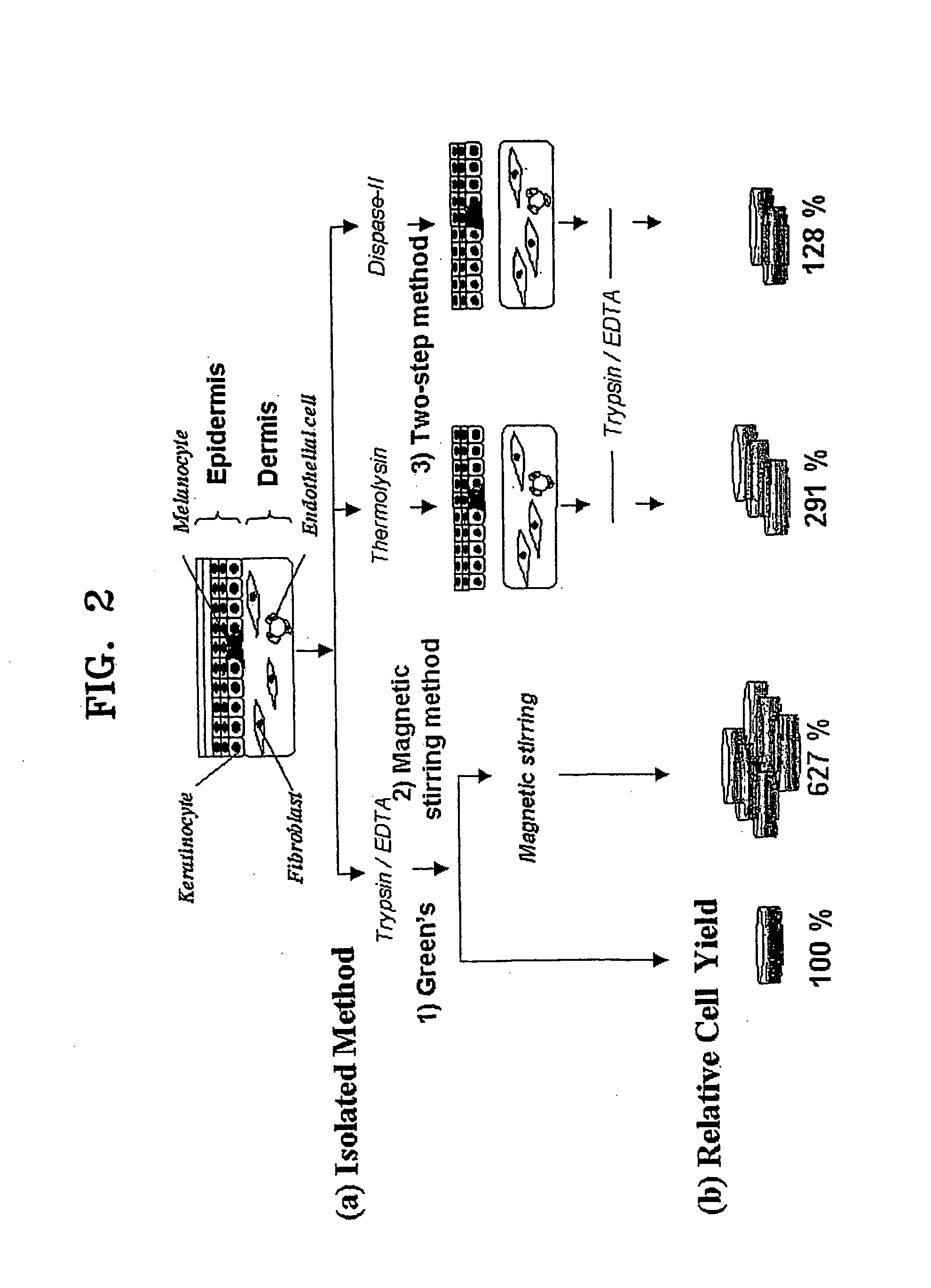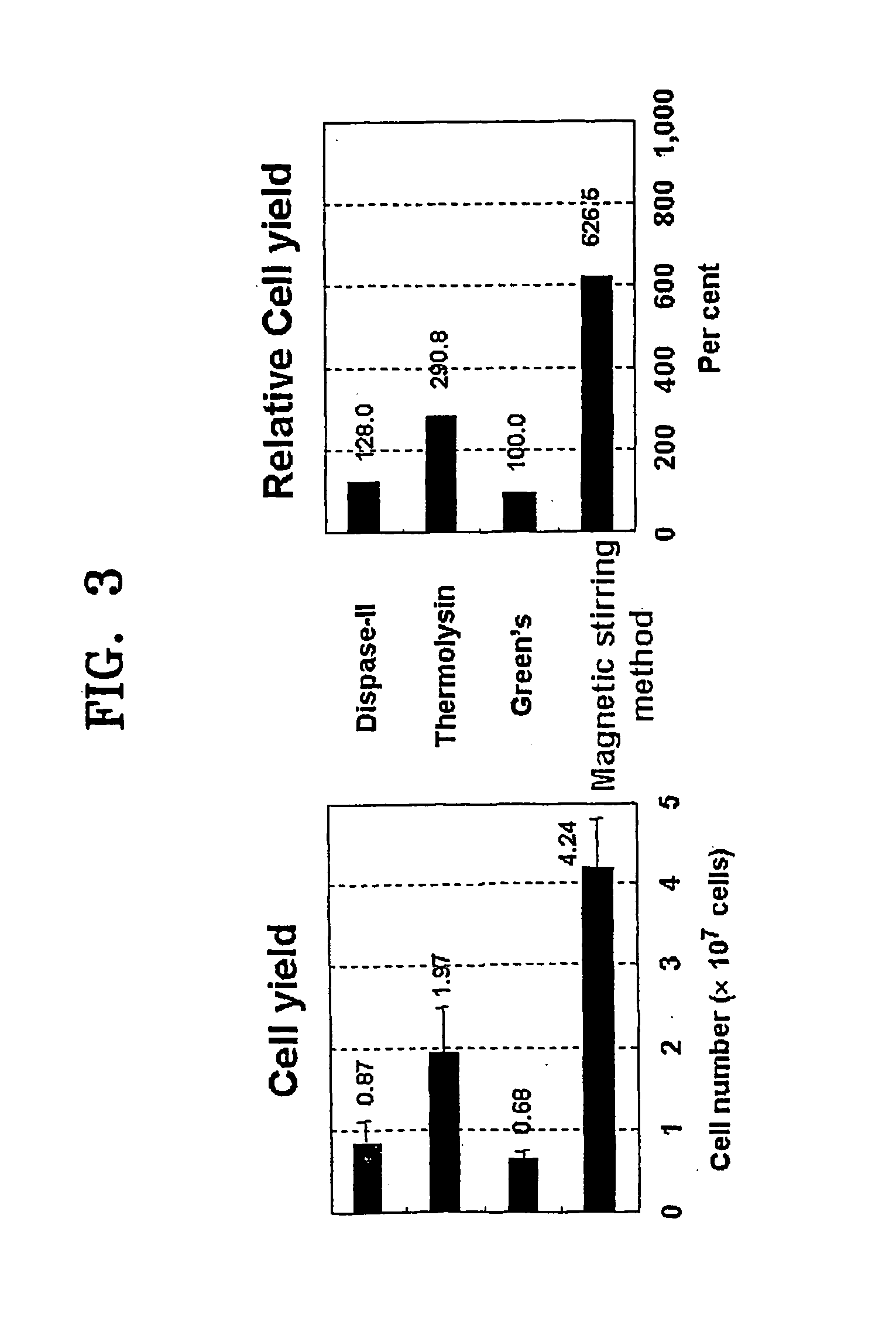Method of isolating epithelial cells, method of preconditioning cells, and methods of preparing bioartificial skin and dermis with the epithelial cells or the preconditioned cells
a technology of which is applied in the field of isolating epithelial cells and preconditioning cells, can solve the problems of difficult identification of these two types of cells from each other, skin tissue or internal organ damage, and stem cells are expected to not be easily separated
- Summary
- Abstract
- Description
- Claims
- Application Information
AI Technical Summary
Benefits of technology
Problems solved by technology
Method used
Image
Examples
example 1
Cell Isolation and Culture
[0089] Primary keratinocytes were isolated from adult human foreskins obtained by circumcision. The adult human foreskins were placed in an epidermal minimal medium (hereinafter, E-medium) containing 1% penicillin, streptomycin, and 250 ng / ml Fungizone (Cat. No. 15240-062, Gibco) at 4° C. before cell isolation. Primary keratinocytes were isolated not later than 24 hours from circumcision.
[0090] The foreskin sample was washed at least 8 times in a phosphate buffered saline (PBS) solution containing 5% penicillin / streptomycin. Subcutaneous tissue was mostly removed from the dermis of the foreskin sample with a pair of sterile surgical scissors, and the remaining portion was cut into tissue fragments not larger than 1-2 mm2.
[0091] Cell isolation was carried out by four methods, (i) magnetic stirring method according to the present invention, and conventional methods including (ii) Green's method, (iii) thermolysin method, and (iv) dispase method, based upon...
example 2
Fluorescence Activated Cell Sorting (FACS)
[0101] Levels of β1-integrin expression in cells isolated in Example 1 according to the four methods were compared by FACS to measure the percentage of β1-integrin bright cells in the isolated cells, which could be predominantly expressed with β1-integrin known as a stem cell marker. The cells isolated by the respective four methods were incubated along with β1-integrin antibodies (Chemicon) and followed with fluorescein isothiocyanate (FITC)-conjugated goat anti-mouse antibodies on ice for 45 minutes. The cells were washed in phosphate buffered saline (PBS) containing 5% bovine serum albumin (BSA). At the end of staining, cells were resuspended in a medium at a density of 1×106 cells / ml and sorted using a FACStarPlus (Beckton Dickinson). At least 10,000 cells were analyzed by flow cytometry in each experiment. The results of each experiment was calibrated using fluorescent native antibodies and isotype control antibodies (refer to Effect 4...
example 3
[0102] Keratinocytes isolated in Example 1 were cultured on coverslips and fixed for 10 minutes at 4° C. in a 1:1 mixture of ethanol and methanol. To identify whether the isolated and cultured cells exclusively consisted of keratinocytes, the fixed cells were stained with pan-cytokeratin antibodies acting as an epithelial cell marker (refer to FIG. 8 and Effect 2). In addition, the fixed cells were stained with α2 integrin antibodies (chemicon) to determine whether the isolated and cultured cells showed basal cell characteristics (refer to FIG. 8 and Effect 4), and with involucrin antibodies to determine the number of differentiating cells (refer to FIG. 8 and Effect 5). The β1 integrin and α2 integrin antibodies used were mouse monoclonal antibodies, and the pan-cytokeratin (Novocastra) and Involucrin (Biomedical Technologies, a keratonicyte differentiation indicator) antibodies used were rabbit polyclonial antibodies. Cell incubation in the presence of primary antib...
PUM
| Property | Measurement | Unit |
|---|---|---|
| elongation | aaaaa | aaaaa |
| frequency | aaaaa | aaaaa |
| diameter | aaaaa | aaaaa |
Abstract
Description
Claims
Application Information
 Login to View More
Login to View More - R&D
- Intellectual Property
- Life Sciences
- Materials
- Tech Scout
- Unparalleled Data Quality
- Higher Quality Content
- 60% Fewer Hallucinations
Browse by: Latest US Patents, China's latest patents, Technical Efficacy Thesaurus, Application Domain, Technology Topic, Popular Technical Reports.
© 2025 PatSnap. All rights reserved.Legal|Privacy policy|Modern Slavery Act Transparency Statement|Sitemap|About US| Contact US: help@patsnap.com



